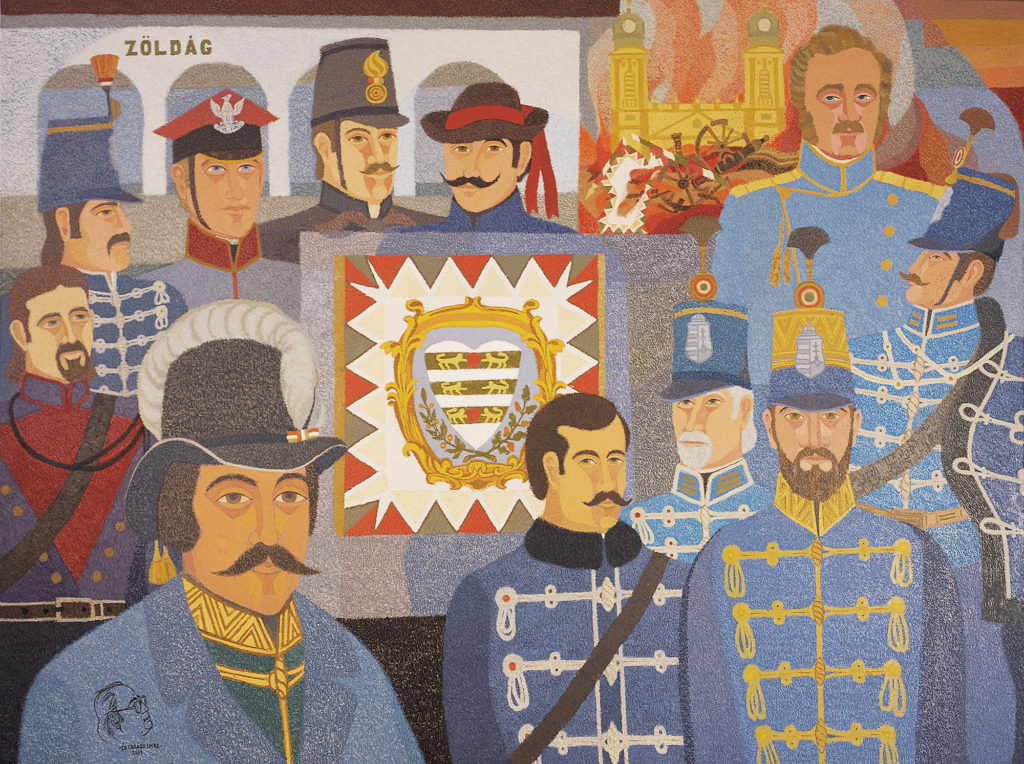Imre Égerházi “farewell artwork” – Battle of Debrecen of József Nagysándor, August 2, 1849
Panneau in the vestibule of the Hajdúhadház town hall.
Critique by Ágoston Székelyhidi
Hajdúhadház not only celebrates the Hungarian Millennium, but also enriches the series of works of national commemoration. At the heart of the city celebration is the inauguration of Imre Égerházi’s panneau. This work is linked to the history of the nation in such a way that it captures the tradition of the city and the Hajdú population. In particular, it depicts the Battle of Debrecen in 1849, one of the last battles of the War of Independence fought to win freedom. It is certain that the life and security of the Hungarian state depended on independence for a thousand years. In our country, independence means not only individual and communal behaviour, but also the protection of the values created by the nation, and the continuity of creating these values. That’s why we value independence particularly high, which is why it’s surrounded by a bright circle of legends of heroism and sacrifice. Such a legend is attached to Hajdúhadház and its surroundings.
This legend draws from the battle between the Hungarian freedom fighters fighting for the country’s independence on August 2, 1849, and the opposing Austro-Russian army. The freedom fighters were on their last legs that time. Here, in the vicinity of Hajdúhadház and Debrecen, the soldiers of General József Nagysándor confronted only the goal and hope of interception and time-winning, not even victory. Yet they knowingly took on the fight, the sacrifice. History calls this losing but heroic and sublime act of war the Battle of Debrecen.
Imre Égerházi first heard about the legend of the battle of Debrecen as a schoolboy, in his hometown, Hajdúhadház. According to this legend, a group of Hungarian officers prepared the war plan at the Zöldág Inn on the outskirts of the city. Pencil sketches attest to the fact that the conscious boy once conceived of the intention of depiction sometime around 1940. After several versions, now, in the years of the Hungarian millennium, Imre Égerházi has fulfilled his human and artistic goal. Thus, the large-scale panel is based on a summative, mature approach.
We see unusual battle scenes here. Imre Égerházi articulates the legend of the heroic and sacrificial defenders of national independence in the language of painting. This painted legend evokes the freedom fighters of the Battle of Debrecen by associating authentic features with symbolic elements. After all, it expresses the process of becoming a legend itself – the way in which persons, places, objects, things are transcended and then become carriers of spiritual, moral meanings in the national community memory.
He places the motifs on a horizontal surface with a symmetrical division. In the upper lane, he characterizes the setting, with the Zöldág Inn in Hajdúhadház and the Great Church of Reformation in Debrecen. The main characters are grouped in the middle field. General József Nagysándor is surrounded by Hajdú soldiers, the “red bandages” of Debrecen, the officers of the Székely cavalry, the Hunyadi grenadiers and the Polish legionaries. This field and the contacting lower field are dominated by an extensive shape: the real-life wolf-toothed, Áprád-striped, heraldic badges are condensed into a symbolic historical unit. The figure of József Nagysándor and the Russian warlord, Prince Paskievics, appear as interesting highlights. These prominent figures appear as opposites of each other, but at the same time locked in equilibrium of struggle.
Imre Égerházi leaves the unnecessary details. In addition to the symbolic faces, figures and buildings, he includes the battle clouds of destruction and fire, the shattered cannons, and the torn and scorched flags. Thus, no detail distracts from the totality of the symbols.
The flattened surface of the panneau and its noble, simple color scheme also fit organically into the artistic intent. The effect is elevated and evokes a poignant identification – an effect we feel worthy of heroic and sublime national legends. Together with this panneau, Imre Égerházi enriched his own oeuvre, his hometown and the festive occasion of the Hungarian millennium.
Ágoston Székelyhidi
August 19, 2000


